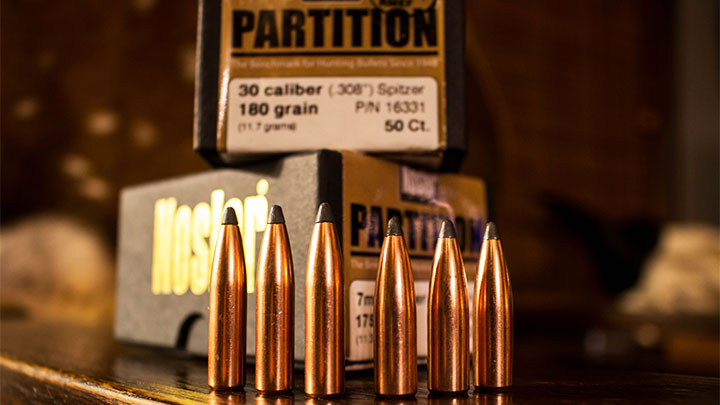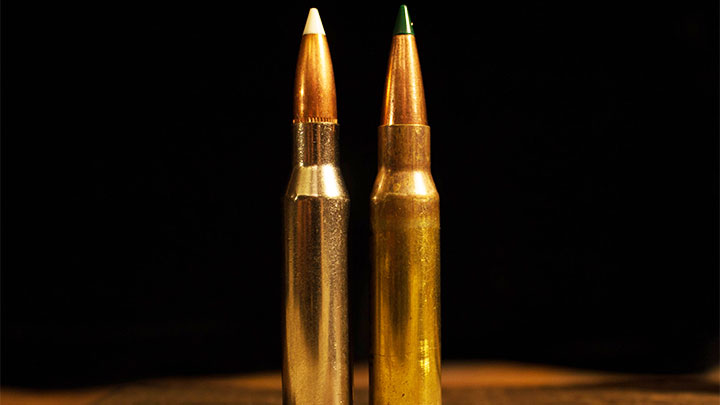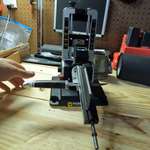
This one is a favorite campfire argument, one which will probably have no end. Maybe it doesn’t need to end, maybe there is room in the hunting world for both bore diameters, but they share so many qualities that hunters end up choosing between the two. Both offer similar power levels, both are suitable for similar species and sizes of game animals and both make a perfect all-around rifle for nearly all hunting scenarios, save the thick-skinned heavyweights.

Depending on where you grew up, who your influences are, and what you were exposed to, you may sit firmly in one camp or the other. I was raised as a congregant of the Church of .30 Caliber. My dad joined the National Guard in 1968—just out of high school at the height of the Vietnam War—and during basic training became enamored with the performance of the 7.62x51mm NATO. Upon returning home, at the ripe old age of 19, he purchased a Mossberg Model 800A bolt-action .308 Winchester, which still shoots very well in spite of a half-century of hard service. A few years later, he added a Winchester Model 100 autoloader—again in .308 Winchester—for additional firepower on deer drives.

It would be years before he’d look past the .308 or .30-30 WCF, and admit the merits of the .300 Magnums; hunting moose and caribou in Quebec inspired the purchase of a .300 Winchester Magnum and a .300 Remington Ultra Magnum. When I violated church doctrine by purchasing a .375 H&H Magnum, I received a proper scolding, as in dad’s mind, nothing more or less than .30-caliber was needed. “It’s got bullets from 110 grains to 220 grains and will kill whatever you point it at. Just put the bullet in the right place and you’re all done, no need for all the weird cartridges.” So sayeth my father. I’d spend a bunch of time behind the trigger of the .308 and .300 Winchester, as well as the .300 H&H, with no complaints whatsoever.
I also know hunters and shooters who are equally fervent about the 7mm bore diameter. Jon Sundra, who’s been writing articles longer than I've been alive, is one. Jon has preached the virtues of the 7mm for as long as I can remember, including developing his own cartridge for the bore diameter. Sundra, along with a good number of gunwriters, sang the praises of various 7mm cartridges—not that I was ever exposed to them in my youth—but I would be in my 20s before I’d have any experience with a 7mm. On Thanksgiving Day 1993, a hunting buddy deemed it too cold out to sit for deer, and insisted I took his Remington 7400 chambered in .280 Remington. I took my first real deer with that rifle on that afternoon, sending a 140-grain Core-Lokt and anchoring a mature eight-point whitetail. I would go on to embrace the 7mm-08 Remington, the .275 Rigby/7x57mm Mauser and the .280 Ackley Improved over the years, all giving more than satisfactory performance in the field and at the bench.

So where are the major sticking points between the two calibers? What makes or breaks the deal, in order to choose one over the other? Let’s take a closer look.
The U.S. Army went four-in-a-row with .30-caliber cartridges, starting with the .30-40 Krag, then the .30-03 Springfield, quickly changing to the .30-06 Springfield, ending with the 7.62x51mm NATO, or .308 Winchester. The European 7x57 Mauser made a definite impression upon the U.S. in the Spanish-American War, and the case was the basis for the Springfield cartridges, but that 7mm bore diameter made a splash across Europe, Britain and the respective colonies. Rigby renamed the 7x57mm to the .275 Rigby, and Holland & Holland had a .275 H&H Magnum in 1912, months prior to the .375 H&H Magnum; the 7mm bullet diameter was here to stay.
7mm isn’t 7mm; it is actually 7.21mm. And .308 isn’t 7.62mm, it’s 7.82mm. But what’s in a name? In my mind, there are direct correlations between these two which can both confuse and direct the shooter to make a choice, though premium projectiles may have blurred those lines in recent years. Looking at bullet weight, the 7mm offers bullets ranging between 100 grains and 195 grains (though a fast twist rate is required for the latter). Most conventional ammunition will top out at 175 grains, though, unless you’re looking at a serious long-range setup. The .30-calibers use bullets weighing between 100 or 110 grains (usually reserved for the .30 M1 Carbine) and 220 grains, with the extremes as heavy as 250 grains. It was the choice of bullet weight which hooked my father on .30-caliber, though truth be told, I've never seen him use anything heavier than 200-grain bullets, and I’ve loaded all his ammo for the last quarter century.

Most folks stay in the middle of the bullet weight spectrum, meaning that the most popular in 7mm will be between 120 and 160 grains, and the most popular .30s will be 150-200 grains. I’ve used the 125-grain bullets in my .308 Winchester, and the 220-grain round nosed slugs in my .300 Winchester Magnum, both with good effect, but the majority of my time has been spent with the 150-, 165- and 180-grain .30s. My time with the 7mms has been mostly spent with the 140-, 150- and 160-grain bullets, as they offer the most flexibility. The 160-grain Federal Trophy Bonded Tip works wonderfully in my .280 AI, the 140-grain Nosler AccuBond is perfect for the Tikka T3x Lite 7mm-08 Remington I take to the Catskill Mountains, and I had a ball using a Rigby Highland Stalker in .275 Rigby with Hornady’s 140-grain InterLock load. I took my best feral hog and best whitetail with that combination.
There are parallels in case capacity between the two bores. Think 7mm-08 Rem/.308 Winchester, .280 Remington/.30-06 Springfield, 7mm Remington Magnum/.300 Winchester Magnum, 7mm RUM/.300 RUM. The sectional density of the 7mm bullets of comparable weight gives them an advantage over the .30s, though the additional weight and frontal diameter of the .30 caliber projectiles swing the pendulum back the other way.

Looking at sheer availability, you can’t really get more popular than the .308 Winchester and .30-06 Springfield, and no 7mm will compare with the volume of ammo available. It still seems that every new hunting rifle that is released is initially available in .30-06 Springfield; it remains a staple in our industry. I will base my decision on whether or not you’re the hunter who intends to pair your choice with a big-bore rifle: if you’re looking at a .35 Whelen or .375 H&H to do the heavy work—or if largest species are truly off the menu—the 7mm will certainly handle the responsibilities of the medium-caliber rifle. If you’re the type of hunter who wants just one big-game rifle—and there is nothing wrong with that—I definitely give the advantage to the .30 caliber. Put another way, I’d feel much more comfortable pursuing coastal brown bear with a .300 Magnum and premium 200- or 220-grain bullets than I would with any 7mm, irrespective of velocity, though I’d much prefer a three-seven-five for that job.
With premium bullets, the traditional 7mms like the .280 Remington and 7mm Remington Magnum are wonderful performers, and are better than they’ve ever been, but the additional weight, selection of projectiles and rampant availability of the .30-caliber cartridges present an advantage. While we hunters often feel the need to quantify every little aspect of our ammunition, I feel confident saying that if a bullet of either caliber—if of appropriate sectional density and construction to ensure proper penetration—is placed in the vital organs, few game animals will be able to tell the difference.
Looking for previous installments of our "Head to Head" series? We've got you covered.
• 6.5 Weatherby RPM vs. 6.5 PRC
• .338 Win. Mag. vs. .340 Wby. Mag.
• .300 RSAUM vs. .300 WSM
• .500 Jeffrey vs. .505 Gibbs
• 7mm RUM vs. .300 RUM
• .308 Winchester vs. 7mm-08 Remington
• 6.5 Creedmoor vs. .260 Remington
• .303 British vs. 8x57 Mauser
• .30-06 Springfield vs. All Other .30s
• .17 HMR vs. .17 WSM
• .450 Nitro Express vs. .470 Nitro Express
• 350 Legend vs. .35 Remington
• .280 Ackley Improved vs. 7mm Rem. Mag.
• .404 Jeffery vs. .416 Rigby
• .243 Winchester vs. 6mm Creedmoor
• .300 PRC vs. .300 Win. Mag.
• .30-06 Springfield vs. .270 Winchester
• 6.5 Creedmoor vs. 7mm-08 Remington
• 8x57 Mauser vs. .318 Westley Richards
• .358 Winchester vs. .350 Remington Magnum
• .22-250 Remington vs. .220 Swift
• .270 Winchester vs. .270 WSM
• .26 Nosler vs. 6.5-300 Weatherby Magnum
• .458 Win. Mag. vs. .458 Lott
• 7mm Rem. Mag. vs. .300 Win. Mag.
• .243 Winchester vs. 6mm Remington
• 7x57mm Mauser vs. 7mm-08 Remington
• .25-06 Remington vs. .257 Weatherby Magnum
• .338 Winchester vs. .375 H&H Magnum
• .30-30 Winchester vs. .35 Remington
• .257 Roberts vs. .250-3000 Savage
• .270 Winchester vs. .280 Remington
• .35 Whelen vs. 9.3x62mm Mauser
• .416 Rigby vs. .416 Remington Magnum
• .308 Winchester vs. .30-06 Springfield
• .22 Nosler vs. .224 Valkyrie
• .300 Win. Mag. vs. .300 WSM
• .223 Remington vs. .22-250 Remington



































